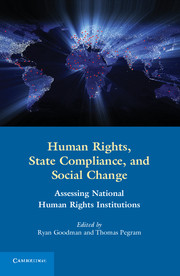Book contents
- Frontmatter
- Contents
- Contributors
- Preface
- 1 Introduction
- PART I NHRIs in Theory and Reality
- 2 National Human Rights Institutions and State Compliance
- 3 The Shifting Boundaries of NHRI Definition in the International System
- 4 Evaluating NHRIs
- PART II NHRI Performance
- PART III NHRIs and Compliance
- PART IV Final Reflections
- Annex 1
- Index
- References
4 - Evaluating NHRIs
Considering Structure, Mandate, and Impact
from PART I - NHRIs in Theory and Reality
Published online by Cambridge University Press: 05 June 2012
- Frontmatter
- Contents
- Contributors
- Preface
- 1 Introduction
- PART I NHRIs in Theory and Reality
- 2 National Human Rights Institutions and State Compliance
- 3 The Shifting Boundaries of NHRI Definition in the International System
- 4 Evaluating NHRIs
- PART II NHRI Performance
- PART III NHRIs and Compliance
- PART IV Final Reflections
- Annex 1
- Index
- References
Summary
Introduction
Scholars and practitioners of human rights have long espoused the centrality of “the local” – as opposed to “the international” for international human rights promotion and protection. It is the job of national human rights institutions (NHRIs) to connect the local with the international, making immediate and concrete what appeared previously to be far away and abstract. This localization of rights is an essential, ongoing process. Progress in human rights standard setting, promotion, and enforcement is not possible without local buy-in. It is the local embrace of rights and the institutions they espouse that give them their legitimacy. The benefits of “embedding a human rights institution within the state” include “the fact that the institution can work closely with government in implementing human rights, while still retaining a critical independence; the institution’s awareness of the socio-cultural context into which the panoply of human rights must be translated; and, the sense of ownership by civil society of the human rights institution and the principles it embodies.”
Human rights treaty drafters now routinely seek to account for national level implementation by inserting specific provisions into treaty texts, seeking to confer monitoring roles on NHRIs, or, indeed, to prompt their establishment. For example, the drafters of the UN Convention on the Rights of Persons with Disabilitiesspecifically incorporated a provision addressing national level monitoring and implementation and called upon states to endow an independent national human rights institution with monitoring responsibilities, as well as a far-reaching article of general application on awareness-raising. While NHRIs cannot make up for a lack of workable domestic human rights institutions, they can use their investigation function to press for adequate remedies and to hold institutions accountable. By issuing reports exposing abuses, they can create public concern, and educate both government and the general public as to new courses of action.
- Type
- Chapter
- Information
- Human Rights, State Compliance, and Social ChangeAssessing National Human Rights Institutions, pp. 74 - 90Publisher: Cambridge University PressPrint publication year: 2011
References
- 2
- Cited by



